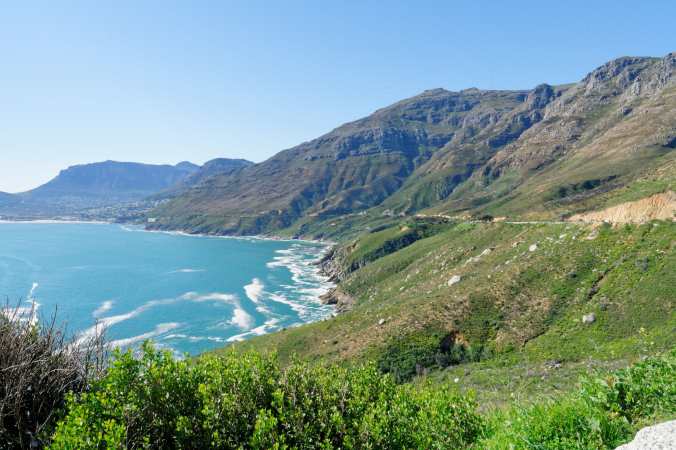A few months ago I was lunching with Robin Middleton, one of my doctoral advisors, who was born and trained in South Africa — Cape Town, I think– before immigrating first to the UK, then, eventually, to New York City. Discussing the around-the-world trip, I ventured the possibility of South Africa as a destination, as dear friends of ours treasure the year that they lived with their then-small, now-grown children in Grahamstown,

home of august institutions of higher learning and host of the annual, renowned Grahamstown Arts Festival, which attracts performing artists and musicians from all over the continent.
South Africa? Robin remarked. It’s quite beautiful. But there’s nothing for you there.
He meant buildings. I fell in love with architecture at around age 17. Since then, I’ve traveled to dozens of countries; not a single year has passed without my boarding at least one plane to some far-flung (though this trip has made abundantly clear that that’s a relative term, always) location. As Danny, Gideon, and I planned our round the world adventures, I realized that I undertook practically every one of those prior trips with the explicit purpose of seeking out buildings by specific architects, or analyzing urban configurations, or studying architecture, urban, and landscape history. Singapore: Safdie, WOHA, the impressively progressive city planning. India: Kahn’s Ahmedabad, Le Corbusier’s city of Chandigarh, Old Delhi and New Delhi, Moghul monuments, Rajput forts. Even Iceland, where I went to seek out the work of Granta, an impressive Reijkavik-based firm. Colonial, missionary outposts and mining towns in northern Mexico.
In this RTW trip, cities and buildings share equal billing with animals (safari), birds (Lake Manyara, Birds of Eden in South Africa),

savannahs (Serengeti in Tanzania), deserts (Sossussvlei in Namibia), bodies of water (black-green fjords in Norway, the Indian Ocean), beaches (Port Elizabeth and the Garden Route).

And with a cosmopolis of mountains: mountains in schist and gray granite, mountains in red sandstone, mountains of sand, aka dunes. Mountains covered in scrub brush and green.
This wider-angled approach to traveling, analogous to swapping out my well-worn 55-200 mm. zoom for the 16-35 mm one I’m currently using, has proved a liberation of sorts, about which I was needlessly anticipatorily anxious.
South Africa. Family, educational, and social obligations, along with many long days of driving from place to place, have simultaneously occupied our minds and kept us away from our computers. So to begin, I shall summarize our itinerary. We landed in Johannesburg and loaded everything directly into our sturdy Rav 4 Toyota SUV rental for the long drive south east, through Gautung and parts of Kwazulu-Natal and the Eastern Cape to the northern tip of the Royal Natal National Park in the Drakensberg, where we planned to hike the hair-raising (couldn’t be nail-biting, because you need both hands to ascend) Sentinel, which appears on many lists as one of the greatest hikes on the planet. After a few days in the Witsieshoek Mountain Lodge, we loaded everything into the car, driving south to the city of Port Elizabeth via the Golden Gate National Park, the desiccated and lovely landscape of the Free State, and through the Eastern Cape.
It’s winter here. A first thing we discovered about South Africa is that central heating does not exist. The Drakensburg was particularly uncomfortable: now I know why so many Africans walk around with ski-hats on their heads. It’s cold! The area where the Wietsihoek lodge is located rises around 6,000 feet above sea level. One day 120-km-per-hour winds forced one group of hikers that we met (after they survived) to crawl, literally crawl, across a mountain ridge to avoid being blown away.
Danny has goaded me into writing more about the hike up the Drakensburg escarpment to the Sentinel and the bowl-like Amphitheater, which at its highest point rises about 10,000 feet above sea level. And I’m happy to comply.

At first, the hike takes you up a path nicely outfitted with pavers; shoes get a good grip as you survey the expanse of Phuthaditjhaba’s surrounding valley. But within 45 minutes you find yourself leaning into sheer, sloping rock planes, searching for toe-holds, and the real tenor of the expedition reveals itself. One unlucky slip could be fatal, tumbling your helpless body hundreds of feet into that ravishing ravine.

Danny prudently retreated, leaving me on my own to ascend to the Amphitheater, which included scaling two storied iron ladders, affixed every ten feet or so to 30-50 foot-high cliffs introduced by a narrow landing, really nothing more than a pause in the cliff.
![IMG_6544[15644]](https://coordinatinggoldhagens.com/wp-content/uploads/2017/09/img_654415644.jpg?w=676) (Every guidebook will advise you to be prepared for these, and my experience on them was, I discovered, shared by all my fellow hikers. We all thought we were prepared. No one was prepared.)
(Every guidebook will advise you to be prepared for these, and my experience on them was, I discovered, shared by all my fellow hikers. We all thought we were prepared. No one was prepared.)
The ladder ascent stopped time, opening up one of those – I kid you not – “you can do this, you can do this” moments. I swayed back and forth on that clanking ladder, praying that my hands would stop sweating, or at least stop sweating quite so much. And then! The summit. ![IMG_6539[15643]](https://coordinatinggoldhagens.com/wp-content/uploads/2017/09/img_653915643.jpg?w=676)
Of which I have only this photo, having wisely surrendered the camera to Danny hours earlier. Gideon had reached the legendary amphitheater long before, accompanied by a young Dutch couple.
Together we descended with our new German friends, Jürgen and Kersten, chatting about traveling, and about life with and without children, while their 17-year-old daughter Celina chatted happily with Gideon about American rap music and life aspirations.
![IMG_6552[15646]](https://coordinatinggoldhagens.com/wp-content/uploads/2017/09/img_655215646.jpg?w=676)
By the end of the day, legs were sore, stories were told and recounted, and all of us felt as though we’d honored the majesty of this place.
— Sarah
The picture of the ocean is breathtaking!!!
Glad you’re back safe from the hike
LikeLike